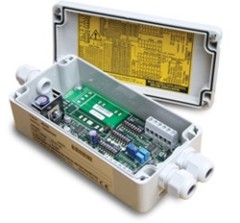 The SGA load cell signal conditioner has a built-in Shunt Calibration function. Switch 8 of the Span switch, SW1 switches a 120k resistor in parallel with one arm of the bridge to produce a known shift in the Zero point. After calibration, switch in the Shunt Cal feature, note the change in output then switch it out. Use this figure to periodically check the integrity and calibration of the system. The PCB is configured to easily allow the Shunt Cal resistor to be changed to suit your application and load cell impedance.
The SGA load cell signal conditioner has a built-in Shunt Calibration function. Switch 8 of the Span switch, SW1 switches a 120k resistor in parallel with one arm of the bridge to produce a known shift in the Zero point. After calibration, switch in the Shunt Cal feature, note the change in output then switch it out. Use this figure to periodically check the integrity and calibration of the system. The PCB is configured to easily allow the Shunt Cal resistor to be changed to suit your application and load cell impedance.- The Strain Gauge Amplifier can be set to provide 5V excitation as well as the normal 10V level – switch off SW4/8. As well as providing excitation for a strain gauge bridge, this can be useful for supplying power to an intelligent sensor (80mA maximum).
-
An IS1224 module can be fitted to the SGA/D to isolate the bridge and electronics from the DC power supply. This module features a wide 9-36V power supply range making it suitable for automotive applications and other portable installations.Isolating the power supply will prevent ground loops and help minimise noise pick-up.
- The SGA load cell amplifier’s mA output can support both ‘sink’ and ‘source’ modes of operation. ‘Sink mode’ can control current flow either from the SGA’s own 15V supply, an external 5-50V DC supply or a suitable PLC input stage. In this mode neither output connection is common to the load cell. In ‘source mode’ the SGA load cell signal conditioner provides the current which flows through the external load to 0V. This mode has the advantage that the load cell’s ‘EXC -‘, the SGA’s ‘Output -‘ and the power supply negative are all commoned together.
- The SGA has a built-in low pass filter adjustable from 1Hz to 5kHz to reduce noise or the effects of vibration in the measurements.
- The Strain Gauge Amplifier can support high impedance strain gauges such as pressure transducers. Its 0.1 to 30mV/V input range makes it suitable for a wide variety of applications.
- J2, the load cell connector provides a reference voltage of 2.5V or 5V depending on whether the excitation is set to 5V or 10V. Connect a mV source between this point and ‘+Strain Input’ to facilitate calibration from the load cell manufacturer’s published figures.
View the full specifications of the SGA on our Mantracourt website.
